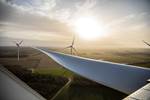Swancor, Siemens Gamesa collaborate on advancing recyclable wind blade technologies
Through Swancor’s recyclable thermosetting resin technologies, the recyclable resin and composites can be reused, assisting Siemens Gamesa in moving towards its goal of providing fully recyclable wind turbines in Taiwan.
Photo Credit: Swancor
(Nantou, Taiwan) and (Zamudio, Spain) have announced a strategic collaboration on recyclable wind turbine blades, with the intention producing them using Swancor’s recyclable thermosetting epoxy resin, EzCiclo. Both companies are committed to supplying customers with environmentally friendly products and recycling solutions to reach a green circular economy and hit carbon neutrality and new materials innovation milestones.
Swancor, an offshore wind power pioneer, has been involved in the research and development (R&D) of recyclable thermosetting epoxy resin since 2015. Its EzCiclo solution and degradation liquid, CleaVER, are currently undergoing the supplier qualification process with Siemens Gamesa, with the aim of being supplied to the wind company.
The combination of the technologies would enable wind turbine blade components to be recovered and recycled after the blades are decommissioned, according to Swancor. The recovered materials, resins and glass fibers can then be used in other applications. The recycling process reportedly does not produce waste solvents and waste gas, and has a low-carbon footprint to help solve environmental challenges which arise from landfill disposal or incineration. This initiative is aimed at reaching the goal of fully recyclable wind turbine blades.
"In order to support Siemens Gamesa in implementing localization commitments in Taiwan, Swancor and Siemens Gamesa are carrying out a strategic collaboration on recyclable blade resins,” Robert Tsai, chairman of Swancor, emphasizes, a statement that is in agreement with Niels Steenberg, general manager of Siemens Gamesa Offshore for Asia-Pacific. “Swancor will continue to be devoted to achieving carbon neutrality and new material innovation as our mission, and contributing to net-zero carbon emissions and a circular economy.”
Related Content
-
Revolutionizing space composites: A new era of satellite materials
A new approach for high volumes of small satellite structures uses low-CTE, low-cost CFRP cellular core, robust single-ply skins and modular panel systems to cut lead time, labor and cost for reflectors, solar arrays and more.
-
Composite bipolar plates provide 81% improvement to hydrogen fuel cell power density
Ultra-thin CFRTP plates developed by Hycco achieve a 7.5 kilowatt/kilogram power density, high durability for fuel cells in long-flight drone and heavy-mobility applications.
-
Trends fueling the composites recycling movement
Various recycling methods are being considered for composites, from novel dismantling and processing, to building capacity and demonstrating secondary use applications.



